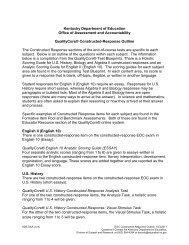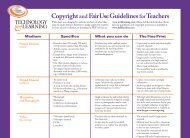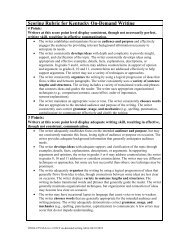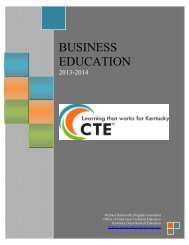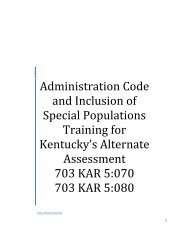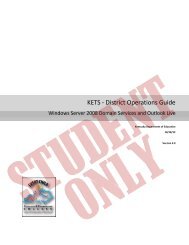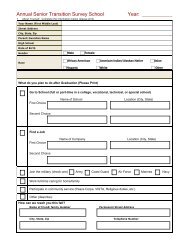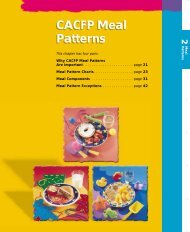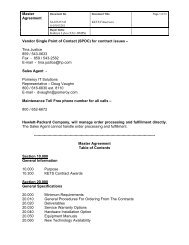Standards with Progressions grades K-HS v. 1.3 - Kentucky ...
Standards with Progressions grades K-HS v. 1.3 - Kentucky ...
Standards with Progressions grades K-HS v. 1.3 - Kentucky ...
- No tags were found...
Create successful ePaper yourself
Turn your PDF publications into a flip-book with our unique Google optimized e-Paper software.
Congruence G-CO<br />
Experiment <strong>with</strong> transformations in the plane<br />
1. Know precise definitions of angle, circle, perpendicular line, parallel line, and line segment, based on the<br />
undefined notions of point, line, distance along a line, and distance around a circular arc.<br />
2. Represent transformations in the plane using, e.g., transparencies and geometry software; describe<br />
transformations as functions that take points in the plane as inputs and give other points as outputs. Compare<br />
transformations that preserve distance and angle to those that do not (e.g., translation versus horizontal stretch).<br />
3. Given a rectangle, parallelogram, trapezoid, or regular polygon, describe the rotations and reflections that<br />
carry it onto itself.<br />
4. Develop definitions of rotations, reflections, and translations in terms of angles, circles, perpendicular lines,<br />
parallel lines, and line segments.<br />
5. Given a geometric figure and a rotation, reflection, or translation, draw the transformed figure using, e.g.,<br />
graph paper, tracing paper, or geometry software. Specify a sequence of transformations that will<br />
carry a given figure onto another.<br />
Understand congruence in terms of rigid motions<br />
6. Use geometric descriptions of rigid motions to transform figures and to predict the effect of a given rigid motion<br />
on a given figure; given two figures, use the definition of congruence in terms of rigid motions to decide if they<br />
are congruent.<br />
7. Use the definition of congruence in terms of rigid motions to show that two triangles are congruent if and only if<br />
corresponding pairs of sides and corresponding pairs of angles are congruent.<br />
8. Explain how the criteria for triangle congruence (ASA, SAS, and SSS) follow from the definition of congruence<br />
in terms of rigid motions.<br />
Prove geometric theorems<br />
9. Prove theorems about lines and angles. Theorems include: vertical angles are congruent; when a transversal<br />
crosses parallel lines, alternate interior angles are congruent and corresponding angles are congruent; points on<br />
a perpendicular bisector of a line segment are exactly those equidistant from the segment’s endpoints.<br />
10. Prove theorems about triangles. Theorems include: measures of interior angles of a triangle sum to 180°;<br />
base angles of isosceles triangles are congruent; the segment joining midpoints of two sides of a triangle is<br />
parallel to the third side and half the length; the medians of a triangle meet at a point.<br />
11. Prove theorems about parallelograms. Theorems include: opposite sides are congruent, opposite angles are<br />
congruent, the diagonals of a parallelogram bisect each other, and conversely, rectangles are parallelograms<br />
<strong>with</strong> congruent diagonals.<br />
Make geometric constructions<br />
12. Make formal geometric constructions <strong>with</strong> a variety of tools and methods (compass and straightedge, string,<br />
reflective devices, paper folding, dynamic geometric software, etc.). Copying a segment; copying an angle;<br />
bisecting a segment; bisecting an angle; constructing perpendicular lines, including the perpendicular bisector of<br />
a line segment; and constructing a line parallel to a given line through a point not on the line.<br />
13. Construct an equilateral triangle, a square, and a regular hexagon inscribed in a circle.<br />
Similarity, Right Triangles, and Trigonometry G-SRT<br />
Understand similarity in terms of similarity transformations<br />
1. Verify experimentally the properties of dilations given by a center and a scale factor:<br />
a. A dilation takes a line not passing through the center of the dilation to a parallel line, and leaves a line passing<br />
through the center unchanged.<br />
b. The dilation of a line segment is longer or shorter in the ratio given by the scale factor.<br />
2. Given two figures, use the definition of similarity in terms of similarity transformations to decide if they are<br />
similar; explain using similarity transformations the meaning of similarity for triangles as the equality of all<br />
corresponding pairs of angles and the proportionality of all corresponding pairs of sides.<br />
3. Use the properties of similarity transformations to establish the AA criterion for two triangles to be similar.<br />
Prove theorems involving similarity<br />
4. Prove theorems about triangles. Theorems include: a line parallel to one side of a triangle divides the other<br />
two proportionally, and conversely; the Pythagorean Theorem proved using triangle similarity.<br />
5. Use congruence and similarity criteria for triangles to solve problems and to prove relationships in geometric<br />
figures.<br />
<strong>Kentucky</strong> Department of Education<br />
Define trigonometric ratios and solve problems involving right triangles<br />
6. Understand that by similarity, side ratios in right triangles are properties of the angles in the triangle, leading to<br />
definitions of trigonometric ratios for acute angles.<br />
7. Explain and use the relationship between the sine and cosine of complementary angles.<br />
8. Use trigonometric ratios and the Pythagorean Theorem to solve right triangles in applied problems. ★<br />
Apply trigonometry to general triangles<br />
9. (+) Derive the formula A = 1/2 ab sin(C) for the area of a triangle by drawing an auxiliary line from a vertex<br />
perpendicular to the opposite side.<br />
10. (+) Prove the Laws of Sines and Cosines and use them to solve problems.<br />
11. (+) Understand and apply the Law of Sines and the Law of Cosines to find unknown measurements in right<br />
and non-right triangles (e.g.,surveying problems, resultant forces).<br />
Circles G-C<br />
Understand and apply theorems about circles<br />
1. Prove that all circles are similar.<br />
2. Identify and describe relationships among inscribed angles, radii,and chords. Include the relationship between<br />
central, inscribed, and circumscribed angles; inscribed angles on a diameter are right angles;the radius of a<br />
circle is perpendicular to the tangent where the radius intersects the circle.<br />
3. Construct the inscribed and circumscribed circles of a triangle, and prove properties of angles for a<br />
quadrilateral inscribed in a circle.<br />
4. (+) Construct a tangent line from a point outside a given circle to the circle.<br />
Find arc lengths and areas of sectors of circles<br />
5. Derive using similarity the fact that the length of the arc intercepted by an angle is proportional to the radius,<br />
and define the radian measure of the angle as the constant of proportionality; derive the formula for the area of a<br />
sector.<br />
Expressing Geometric Properties <strong>with</strong> Equations G-GPE<br />
Translate between the geometric description and the equation for a conic section<br />
1. Derive the equation of a circle of given center and radius using the Pythagorean Theorem; complete the<br />
square to find the center and radius of a circle given by an equation.<br />
2. Derive the equation of a parabola given a focus and directrix.<br />
3. (+) Derive the equations of ellipses and hyperbolas given the foci, using the fact that the sum or difference of<br />
distances from the foci is constant.<br />
Use coordinates to prove simple geometric theorems algebraically<br />
4. Use coordinates to prove simple geometric theorems algebraically. For example, prove or disprove that a<br />
figure defined by four given points in the coordinate plane is a rectangle; prove or disprove that the point (1, √3)<br />
lies on the circle centered at the origin and containing the point (0, 2).<br />
5. Prove the slope criteria for parallel and perpendicular lines and use them to solve geometric problems (e.g.,<br />
find the equation of a line parallel or perpendicular to a given line that passes through a given point).<br />
6. Find the point on a directed line segment between two given points that partitions the segment in a given ratio.<br />
7. Use coordinates to compute perimeters of polygons and areas of triangles and rectangles, e.g., using the<br />
distance formula. ★<br />
Geometric Measurement and Dimension G-GMD<br />
Explain volume formulas and use them to solve problems<br />
1. Give an informal argument for the formulas for the circumference of a circle, area of a circle, volume of a<br />
cylinder, pyramid, and cone. Use dissection arguments, Cavalieri’s principle, and informal limit arguments.<br />
2. (+) Give an informal argument using Cavalieri’s principle for the formulas for the volume of a sphere and other<br />
solid figures.<br />
3. Use volume formulas for cylinders, pyramids, cones, and spheres to solve problems. ★<br />
Visualize relationships between two-dimensional and three dimensional objects<br />
4. Identify the shapes of two-dimensional cross-sections of three dimensional objects, and identify threedimensional<br />
objects generated by rotations of two-dimensional objects. (continued)<br />
62 | P a g e




